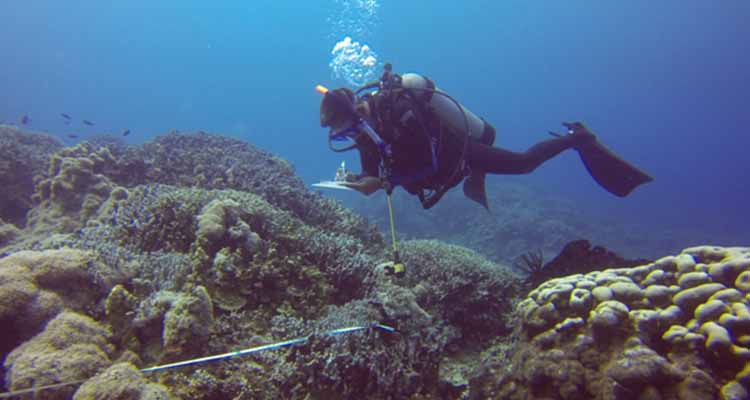
Macajalar Bay hosts several big local industries such as the Philippine Sinter, Del Monte Philippines, Mindanao Container Port, 210 Megawatt Mindanao Coal- Fired Power Plant, and supports around 75,000 coastal population (ESCAP, 1996). As industrial activities expanded and population rapidly increased, research studies conducted in the last decade (1997-2007) indicated a decline in the health conditions of some coastal marine ecosystems (Atrigenio et al., 1998, Aliño et al., 2002).
To establish a long term comprehensive data on the ecological conditions of Macajalar Bay, McKeough Marine Center (MMC) research staff and Biology faculty researchers conducted the 3rd bay resource assessment dubbed ReMODEL MacBay (Resource and Ecological Monitoring for Sustainable Development in MacBay), from April to May 2013. This was a continuation of the biannual survey conducted by MMC that began in 2008.
To determine the status of the coastal resources, assessments were made on four (4) selected permanent sites for comparison over time, namely, Brgy. Buko of Kinoguitan, Brgy. Lower of Jasaan, Brgy. Poblacion of Opol and Brgy. Moog of Laguindingan. Assessments were based on the following biological parameters: (i) coral cover, (ii) fish density and biomass, (iii) mangrove cover, (iv) seagrass cover, (v) seaweed cover, (vi) macroinvertebrate biodiversity and (vii) microinvertebrate biodiversity. A project leader and 1-5 research assistants took charge of each component parameter.
| Component | Project Leader | Field Assistants |
| Coral | Dulce Dawang | Patrice Roa |
| Fish | Fra-and Quimpo | Jaylan Tuba &Timothy Quimpo |
| Mangrove | Lolita Martinez | Tome Genovia, Majen Casinillo, Julie Acero, Paul Sildo, Daniel Linog |
| Seagrass | Gertrude Garcia | Joseph Garcia & Raymund Dumangcas |
| Seaweeds | Elaine Villaluz | Czarmayne Escoro & Jue Lalas |
| Macroinvertebrate | Anita Mabao | June Cabiguin & Shean Roa |
| Microinvertebrate | Kristine Galarrita | Jo Marie Acero |
The target beneficiaries of this study are the bay’s fishing communities, local government units within the bay and the academic communities. After analyses, data results generated should help stakeholders understand better the bay’s ecological conditions given the changes or trends observed over the years. More accurate information and better appreciation of results will equip environmental managers and planners to upgrade coastal management plan and implement effectively an ICM program. Data generated can be used as reference for short term and long term planning of industries and other corporations. Further, data can be used as basis for academic research and for appropriate interventions aimed at addressing future problems in the bay.
This will provide the scientific data needed for a science-based information and education campaign to increase awareness on the plight of the natural resources of the bay.
By: Czarmayne Escoro
Source: E. Villaluz et al. Resource and Ecological Monitoring for Sustainable Development in MacBay (ReMoDel MacBay) Mindanao Research Proposal Submitted to KRC
